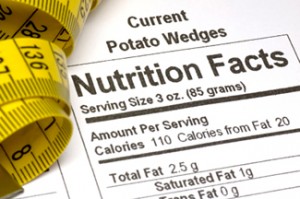By Kac Young PhD, ND, DCH
 Nutrition Facts labels are getting an overhaul. The proposed update, announced last spring, is the first major revision in 20 years and marks the White House’s continuing efforts to improve the eating habits of Americans and to help quell obesity. Food manufacturers will then have a couple of years to comply while the final drafts are undergoing review and approval.
Nutrition Facts labels are getting an overhaul. The proposed update, announced last spring, is the first major revision in 20 years and marks the White House’s continuing efforts to improve the eating habits of Americans and to help quell obesity. Food manufacturers will then have a couple of years to comply while the final drafts are undergoing review and approval.
Below is a brief summary of the proposed changes.
* More realistic serving sizes. Serving sizes will be updated to reflect what people typically consume. For example: who eats just a half-cup of ice cream? (The new serving will be listed for 1 cup.) Manufacturers will also have to declare certain packages (such as 20-ounce soda bottles) as 1 serving (rather than the current 2.5 servings).
* No more “calories from fat.” Dropping this line acknowledges that the type of fat is more important than the amount of fat. Not all fats are bad Knowing the good fats vs. the bad fats should be on your to-do list for 2015.
* Hello “added sugars”—finally. The current label does not distinguish between sugars naturally present (such as the sugar in milk and fruit) and sugars added during processing (such as the sugar added to fruit yogurts and breakfast cereals). Added sugars are a source of “empty” calories that contribute to weight gain.
* Hello potassium and vitamin D. Potassium is key in maintaining healthy blood pressure levels, while vitamin D is essential for bones and may have a range of other health benefits. Yet most people’s diets fall short in both. Highlighting these nutrients in the new label may encourage people to consume more of them. It may also encourage manufacturers to fortify more foods with vitamin D, since few foods naturally contain it.
Although the new label format will continue to list trans fats, the loophole will likely still exist whereby a product with less than 0.5 grams of trans fat per serving can legally claim to have 0 grams. However, be advised that no amount of trans fat is healthful.
Note the daily sodium limit is being reduced from 2,400 to 2,300 milligrams to reflect the general sodium recommendation in the Dietary Guidelines for Americans—but most people (including everyone over 50 and all African Americans) should aim for 1,500 milligrams a day, According to the American Heart Association.
Gravely missing in the proposal is an upper limit for added sugars—the American Heart Association advises no more than 25 grams a day (about 6 teaspoons) for women and no more than 40 grams (10 teaspoons) for men. [1]
The biggest challenge ahead for all of us is to make sure we read the labels, digest the information and weigh our choices carefully. Fresh fruits and vegetables don’t need packaging or labels to be a healthy choice for you.
– Kac Young, a former television director and producer, has earned a PhD in Natural Health and is a Doctor of both Clinical Hypnotherapy and Naturopathy. She is the author of 10 books. Heart Easy is a system of nutritionally sound, delicious meals that promote heart health, long life and taste great. In the Heart Easy Cook Book sound nutritional advice is followed by family favorites that have been turned into heart healthy meals anyone can make and everyone will love.
[1] Food Label Overhaul by John Swartzberg MD writes for Berkeley Wellness
